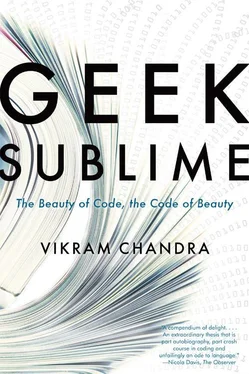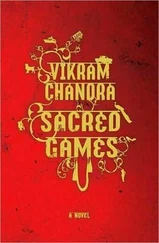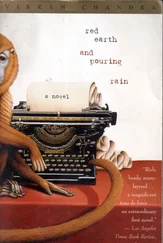Anandavardhana does not claim that he is inventing anything new when he speaks of dhvani : it is “found in the works of great poets. It is that which appears as [something] separate from the well-known elements [of poetry].” The reason we call some poets “great” is because their work is resonant with dhvani , which is something that cannot be described or analyzed by listing their beautiful figures of speech or pointing at their style; dhvani is not accounted for by the then-current theories of alamkara-shastra. And yet, dhvani is what makes poetry beautiful. So Anandavardhana insists that he is just naming something that already exists, and showing us how to think about it. He shows us different kinds of dhvani in verses taken from the epics, from the renowned poets of his era, from famous poems in Sanskrit and Prakrit. For instance:
O holy monk, wander without fear.
That little dog was killed today by him—
that violent lion living in the thickets
on the banks of the Godāvarī River. 41
Here the speaker is a woman, and what is being suggested is a vastu , a narrative element: the woman wants to keep the wandering monk away from a trysting place where she meets with her lover. So what we have here is vastu-dhvani , through which the poet can suggest things, facts, situations, prohibitions, injunctions. In this poem, the denotative meaning is exactly the opposite of what she really wants, what she is really doing; what the reader grasps is beyond abhidha and lakshana. Here is another famous example of vastu-dhvani :
Mother-in-law sleeps down there, and I here.
Look while day remains, O traveler.
Do not, blind in the night,
lie down in my bed. 42
The presumed speaker is a lovelorn woman, a familiar type within the conventions; this married woman is extending — or suggesting — an invitation.
Dhvani can also suggest a figure of speech, an alamkara. So:
O lady with tremulous long eyes,
as your face
completely fills the directions
with the radiance of its beauty,
the ocean now remains calm,
absolutely still.
And so I know it is nothing
but an insentient mass of water. 43
The ocean is not stirred now —as it was a moment ago, when the moon rose — therefore it must be truly insentient. The eyes are tremulous — perhaps from momentary jealousy? — but now the smiling face “fills the directions.” What is being suggested here is a metaphor, the beautiful face as the moon. This is the second variety of suggestion, alamkara-dhvani.
But the most powerful dhvani in poetry, the poet’s most desired effect, is the suggestion of rasa. Rasa is a term which, until Anandavardhana, had mostly been used in dramaturgical texts. At some time between 200 BCE and 20 °CE, a perhaps-apocryphal sage named Bharata is said to have written the Natyashastra (Treatise on the drama). The Natyashastra is a theater professional’s handbook: it includes chapters on what a playhouse should look like; on different gaits; the use of local dialects; costumes and makeup; on the factors that lead to the success of a dramatic performance. The sixth and seventh chapters famously analyze the nature of aesthetic pleasure, rasa. According to Bharata:
People who eat prepared food mixed with different condiments and sauces, etc., if they are sensitive, enjoy the different tastes and then feel pleasure (or satisfaction); likewise, sensitive spectators, after enjoying the various emotions expressed by the actors through words, gestures and feelings feel pleasure, etc. This (final) feeling by the spectators is here explained as (various) rasa -s of natya [drama]. 44
So rasa —the word literally means “taste” or “juice”—is not emotion ( bhava ); it is the aestheticized satisfaction or “sentiment” of tasting artificially induced emotions. Generations of thinkers developed the notion of rasa along with a notion of the ideal viewer; the locus of rasa was this viewer, not the actors or the stage. Rasa is what the drama produces in the sahrdaya , the sophisticated “same-hearted” connoisseur who is the playwright’s necessary counterpart. The sahrdaya —because of education, experience, and temperament — is able to experience rasa precisely because he or she does not identify in a personal, egoistic way with the tragedy on the stage. The naive spectator who ascribes some sort of reality to what is happening on the stage and identifies personally with the emotions of the characters is incapable of rasa , which is an impersonal, disinterested pleasure. One might say that a certain psychical distance is necessary for rasa to be experienced. Rasa is sublime.
On stage, the characters and situation and the patterning of events make up the determinants or catalysts, the vibhava s; the actors portray the consequent outward manifestations ( anubhava s) such as speech, bodily posture, and involuntary reactions (such as trembling). In response to the actors’ depictions of momentary situations like a waiting lover’s anticipation or doubt, the spectator experiences fleeting emotional states ( vyabhicaribhavas ); and all of these various feelings come together — like condiments and sauces — to allow the viewer access to a stable emotion, a dominant mood, a sthayibhava , such as grief. Note that this stable emotion is in the viewer ; it is a “permanent emotional state” that is ever present in all human beings as a potential, a latent trace. The actors cannot act out a sthayibhava —it really doesn’t matter what the actors feel or don’t feel; the purpose of their craft is to allow the sahrdaya access to his or her own stable emotions.
And, very importantly, the stable emotion is not the rasa. If the actors portray a scene that allows access to the stable emotion of grief, shoka , what the viewer relishes is the rasa of karuna , pathos. The rasa is in the tasting of grief, in the relishing of grief, in the reflective cognizing of grief. If the actors portray desire, rati , the viewer relishes sringara , the rasa of the erotic. The pleasure of rasa comes from the meta-experience of experiencing oneself experience the stable emotions.
Bharata names eight rasa s in all; so, in addition to karuna and sringara , the viewer enjoys hasya , the comic; raudra , the wrathful; vira , the heroic; bhayanaka , the terrible; bibhatsa , the disgusting; and adhbuta , the wonderful. A ninth rasa was added by later theoreticians: shanta , the peaceful, which arises from the stable emotion of vairagya , detachment, dispassion, and which is manifested especially by epics like the Mahabharata , which place the specificity of human striving and passion against the vastness of time.
According to Anandavardhana, poetic language can manifest dhvani through the operation of vyanjana , suggestion, and so offer the reader an opportunity to taste rasa. For instance:
While the divine sage was speaking
to Pārvatī’s father,
she, eyes downcast,
counted the petals
of her toy lotus. 45
The “divine sage” has come to propose to Himavata, the king of the Himalayas, that he marry his young daughter Parvati to the god Shiva. Parvati is in love with Shiva, and has performed great austerities to win him, but in this moment, Anandavardhana says, “the counting of the petals of the lotus subordinates itself and without the help of any verbal operation reveals another matter in the form of a transient state of mind ( vyabhicāribhāva ) [of the emotion love, namely shyness].” 46In the perception of the reader, the shyness of Parvati suggests desire, love. The reader therefore relishes the rasa of the erotic, sringara , evoked through dhvani.
Читать дальше












